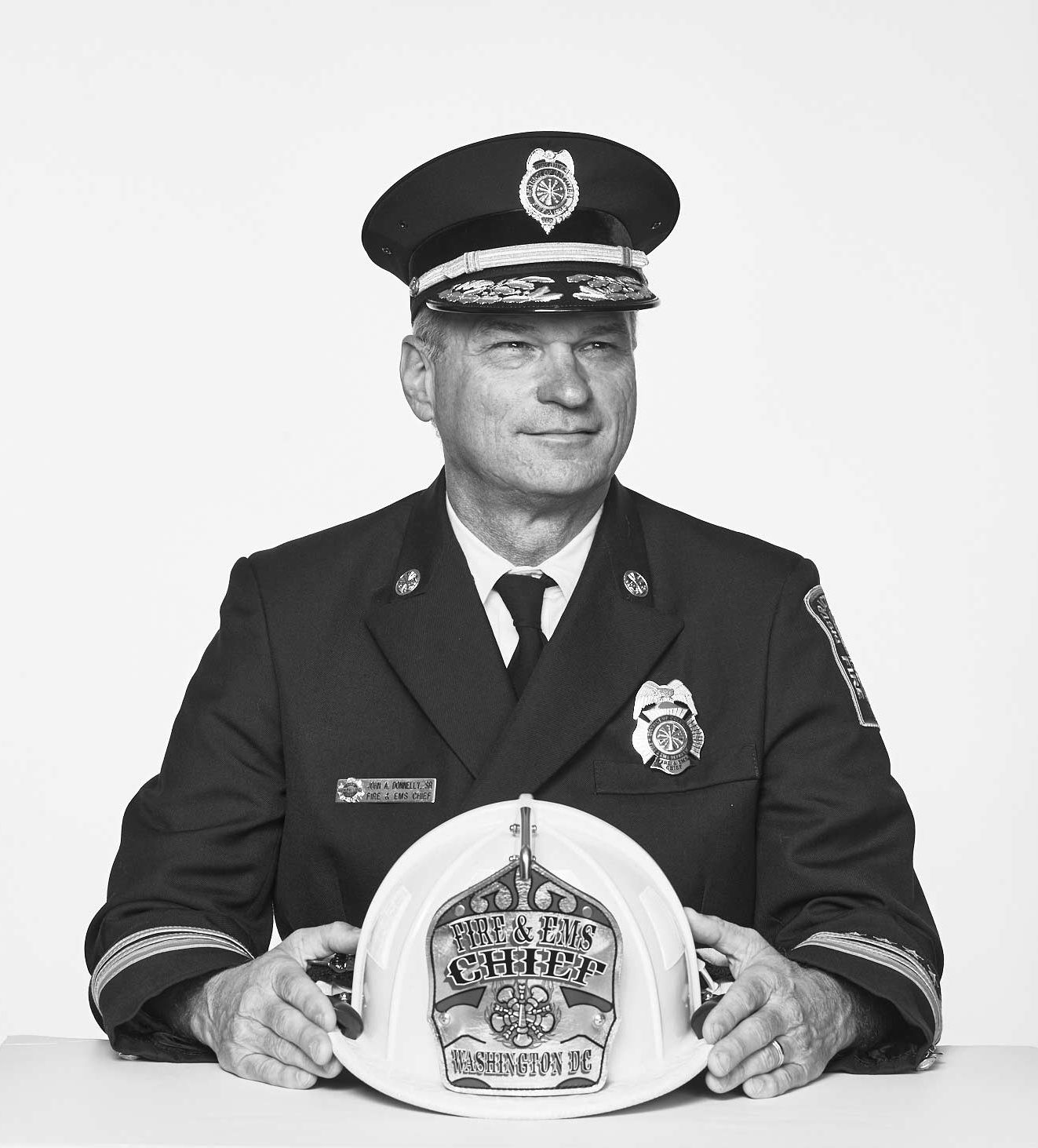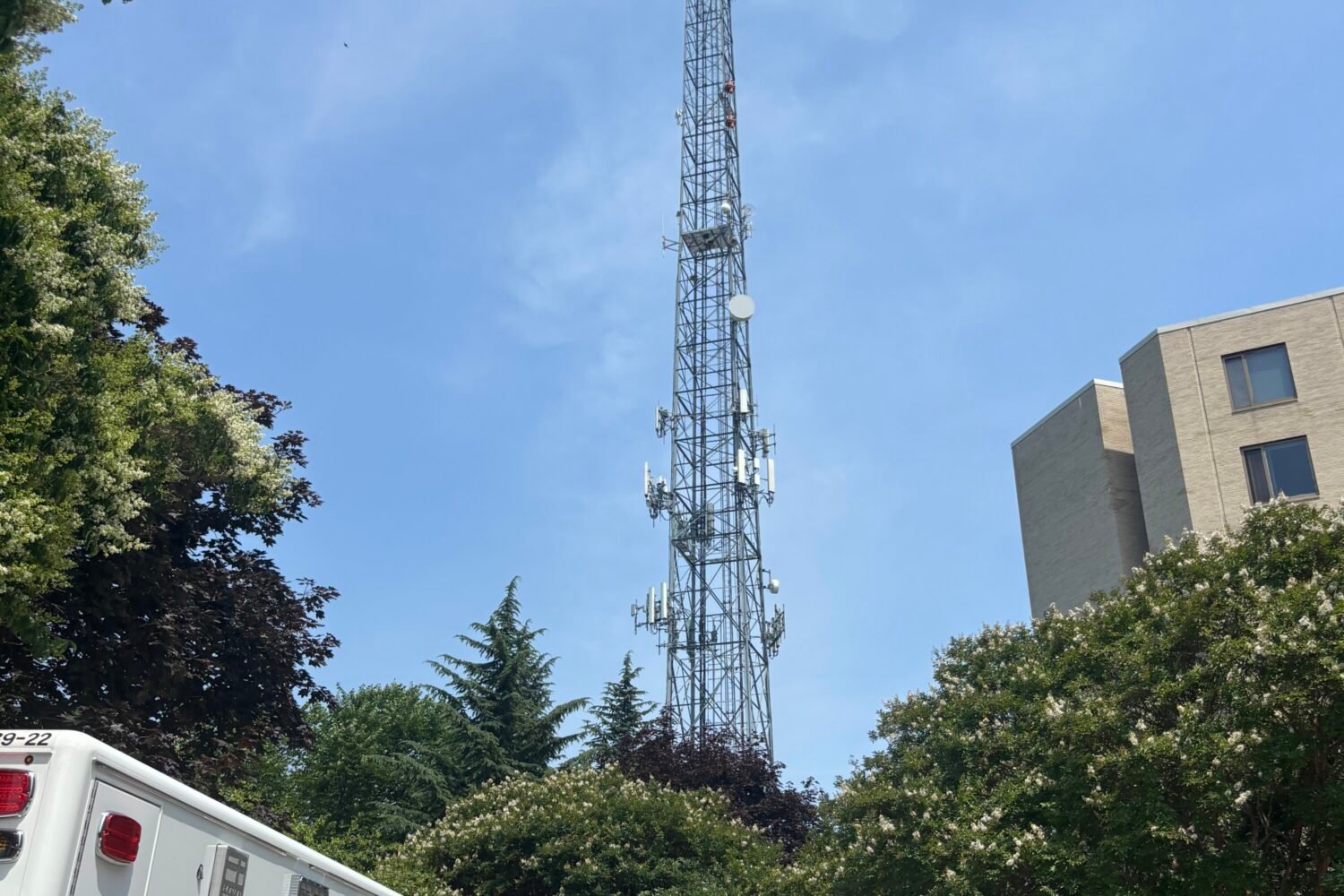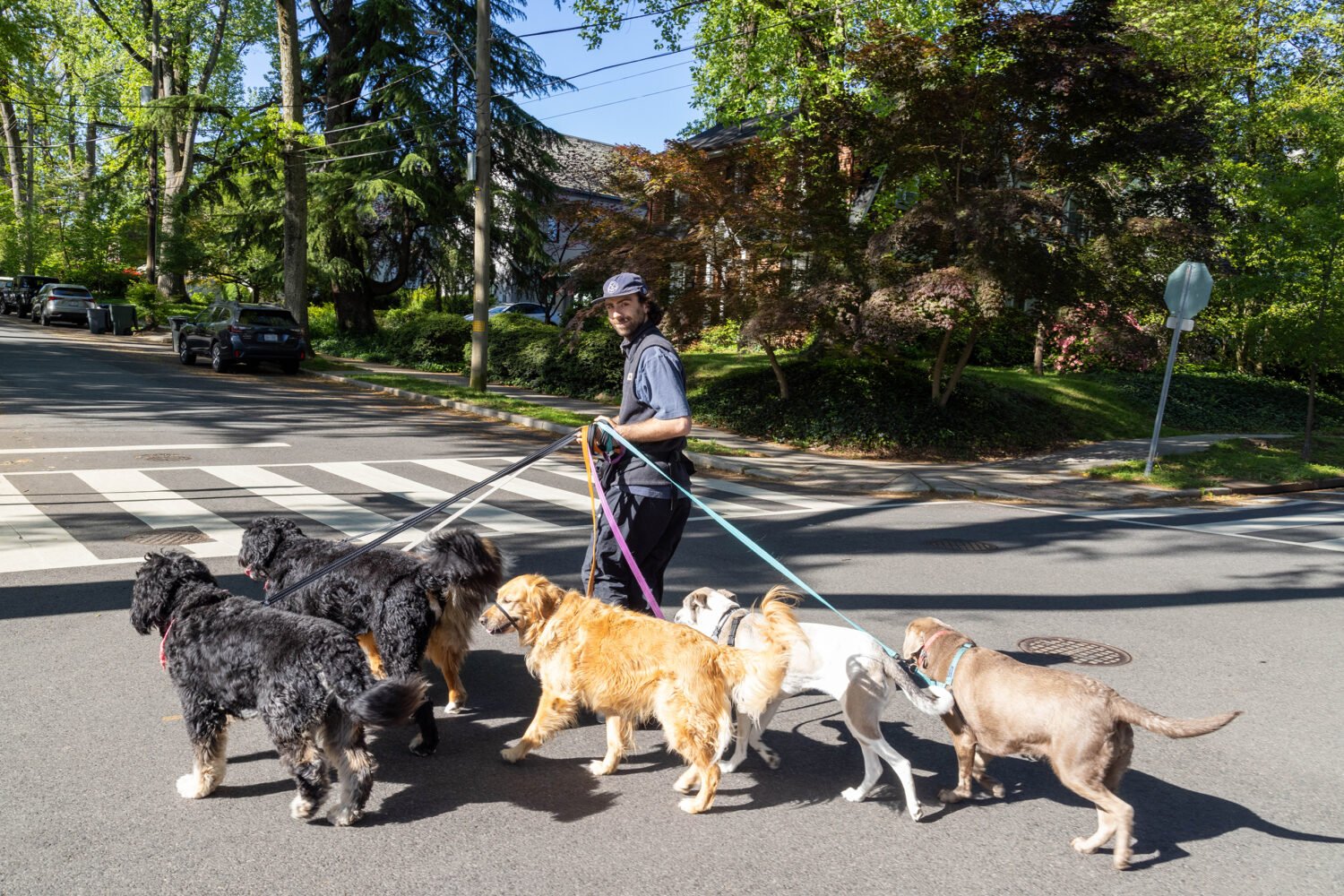DC Fire and EMS Chief John A. Donnelly Sr. has been putting out fires since he was a teen. He started out volunteering in Fort Washington, where he grew up, then did a stint fighting brushfires out west. In his 30-year career with DC Fire and EMS, he has handled everything from structural fires to hazardous materials to planning for terrorism and natural disasters. As of late 2020, he’s been running the whole shebang.
DC’s fire department is currently celebrating its 150th anniversary, so it seemed like a good time to check in with the chief about overseeing a major operation during the last couple years of global crisis. We met up with Chief Donnelly in his windowed corner office at the fire-department headquarters at 14th and U. Even from behind his desk, he was keeping tabs on the action: At one point, he heard a siren on the street below and looked out the window to see if the ambulance stopped briefly at the red light, as it’s required to do. It did. Donnelly said he always follows up with an ambulance crew if he sees poor driving; more firefighters die in vehicle crashes than in fires, he explained. “It’s a safety issue. You can’t let anything slide.”
At age 16, you became a volunteer firefighter. What made you want to do that?
Some of my role models growing up at church were firemen. They were good men, and they resonated with me for some reason. They kept this bratty kid around and gave me errands to do. As I got a little older, [my friends and I] would hang out at night in the McDonald’s parking lot in Oxon Hill, and there was a series of terrible [nearby car] crashes. We always wanted to go up and see what happened. I saw guys I was in school with walking around in fire gear, and they were helping people. I was like, “What are you doing?” They go, “Oh, we’re volunteer firemen—you should come down.” Of course, that’s what I did.
Did you have memorable early successes?
Actually, the successes are sometimes less memorable than the failures. I remember a terrible call with a young man, 12 years old, who had been hit by another kid with a baseball bat. He ultimately died. It was a shock. But the other [responders] involved in that call—it affected them in such a way that they couldn’t perform. And I performed. I realized at that point I was wired a little differently and that I could do this job.
In 1998, you saved an unconscious person from a burning building. What happened?
We had a dispatch for a fire on Hunter Place, and we arrived on the scene with heavy smoke coming out of the building, neighbors in the front yard saying, “Mr. Smith is there, he’s an elderly man, we know he’s home.” We forced the door open, but the fire came out the front door. You’ve got to remember, the rescue squad doesn’t carry water—our job is to search for trapped occupants, generally before the fire is put out. Because once you start putting water on the fire, the steam can do a lot of damage to a person’s lungs.
So while the engine company starts knocking the fire down, my partner and I go upstairs and we start searching. You could feel the heat—you could see the swirls of fire in the air. And if you can see red and feel the heat in your turnout gear, then you’re in a lot of danger. It’s time for you to put the fire out or get out.
As we were searching, my partner and I went into a room, and one of us goes along one wall, one of us goes along the other. It’s pitch-black—you cannot see. You’re feeling the wall, a bed, a bookshelf, but your gloves are thick, like a winter coat. As I was completing the search, I stopped [and briefly sat down]. I said to my partner, “There’s nothing here—let’s go to the next room.” Then we hear something. And he’s like, “What was that?” I’m like, “I don’t know.” Simultaneously, we reach down, and there’s so much debris in there but I’m sitting on top of the victim.
Sorry, what?
Yeah. When I sat on him, I pushed the air out of his lungs and he made a noise, and my partner heard the noise. He wasn’t breathing when we brought him out, but the EMTs and paramedics did an amazing job. And, you know, he was lucky.
In addition to fighting fires, the department handles EMS. What has that been like with the opioid crisis?
The opioid crisis—it’s like this slow burn that sometimes doesn’t make sense. We’ve had heroin in this community for a long time. I do remember when Narcan was new, and as a medic, you’d give Narcan and you could do a countdown—“5-4-3-2-1”—and they’d wake up and people would think you were amazing. Then that evolves into—well, fentanyl used to be something that came up only a little bit, but now it seems to be mixed in everything. We have addicts who are in their fifties and sixties that have been successfully managing a heroin addiction their whole life, and now they’re overdosing and dying. We have to give so much Narcan to counteract the fentanyl that our chances of success are falling. Where it seemed like we used to be able to help people, I don’t know that we’re helping people as much as we’d like to. That’s a challenge.
Another challenge, obviously, is Covid.
One of the things I’m most proud of about our workforce during Covid is that everybody around us was closing fire stations or companies because there were too many people sick, too many people in isolation. We had over 300 people in isolation at one point, and we never closed a fire station. Was it hard? Absolutely. Did some of them work a lot of hours? Absolutely. But we never stopped providing service, and that’s ultimately our job—that’s our goal.
We’ve had—I don’t know that you characterize them as fights, but everything that happens in the world happens in our department. We’re 2,200 employees from all over the place, with different viewpoints and different beliefs. We’ve had to deal with people who don’t want to get the vaccine and people who don’t want to work with anybody that doesn’t have the vaccine. All the noise in the political realm, that trickles down and affects our people.
The fire department was part of the January 6 response. What was that day like?
We knew there was the potential for violence, and my assumption was that we had to be prepared in case Congress did something to overturn the election. I thought our most likely scenario was that we would go into a series of long protests. Coming into it, we had a lot of extra resources in place.
Before noon, I was driving around watching the protesters. We wanted to get the lay of the land before we spent the rest of the day in our operations center. We drove by the Capitol, and they were building a gallows there. I was like, I can’t believe the Capitol Police are letting them do that. They’re going to call us later to take it down, and I don’t want to get involved in that. Then we came around to the Ellipse. We’re sitting at 17th and Constitution—it’s just an agitated crowd. I can remember when President Trump was talking—basically, he says something very inflammatory about Pence. And it’s like, we’ve got to get back to the operations center because this isn’t right, this is going to be bad. He is agitating the crowd—this is inciting, right?
When did you get a sense of how bad it would get?
When we got to the operations center, there’s a lot of buzz. All of a sudden, we start getting hit for EOD [explosive-ordnance disposal] calls—the two explosive-device calls. My initial reaction to the report was: They’re strategically placed as far apart on Capitol grounds as you can get. And that’s bad—that’s on purpose. Almost simultaneous to that—it was probably 15 minutes—the crowd hits the Capitol.
We’re watching the video as the first people start fighting at the Capitol, and within a few more minutes, the first call to the Capitol comes in and it’s CPR. We’re like, what the hell is going on? Then the second CPR call comes in and everybody’s thinking, no, that’s the same call. But the crew is very specific—we have a second one. So we’re sitting there dealing with this, getting resources, and I called the deputy mayor and said, “I think I need to be with you. This is not right. I’ve never seen anything like this.” The deputy mayor says, “I’m going to go over to police headquarters—the mayor is going there.” So I went over to police headquarters.
What happened there?
We walk into the JOCC—the police command center—and the calls are going crazy, right? MPD’s declaring a riot. As the fire chief, we’re part of the city’s consequence-management team. So we start sorting through what we’re going to do. Obviously, my people can’t stop the riot, but we can free police officers up to do it. Can we take over a logistics function? What are the things we can do? I’m so proud of what our people did that day. Nobody flinched. They all went to work.
FEMS is on the frontline of many horrific and traumatic things. How do you keep morale up?
We have developed a lot of different practices over 20 years to try and help people recognize psychological trauma and deal with it. But your support team in the firehouse is your peers, right? You’re at the firehouse for 24 hours [for each shift], so you don’t think of it as a workplace in a lot of ways—you think of it as a home. When you eat together and share your experiences over a meal, it’s supportive. There are things like that in our culture in the fire service that are really helpful for dealing with all of this.
I think my generation uses gallows humor a little more than the current generation, but humor is a dangerous thing. You have to be careful that it doesn’t dehumanize the experience that people are going through. I tell our recruits when they graduate: You’re going to see bad things every day, you’re going to see sick people every day—don’t let that become normal for you. And that’s, I think, what we have to fight all the time. If you don’t recognize when you’re losing your compassion, it’s going to be a hard job for you. But the organization is resilient. The mission is clear.
This article appears in the July 2022 issue of Washingtonian.



















